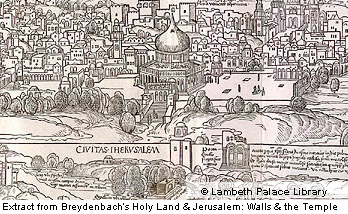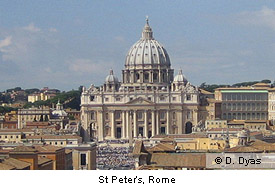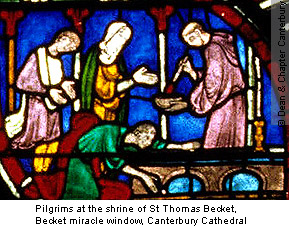
Patterns of Pilgrimage in England c.1100-c.1500
Place Pilgrimage

Growing popularity
Canterbury Tales
Thanne longen folk to goon on pilgrimages,
And palmeres for to seken straunge strondes,
To ferne halwes, kowthe in sondry londes;
And specially from every shires ende
Of engelond to caunterbury they wende,
The hooly blisful martir for to seke
Chaucer, Canterbury Tales, Prologue 12-17
In the centuries following the Norman Conquest, pilgrimage to holy places, already well established in Anglo-Saxon England (see England c.600-c.1000), grew steadily in popularity, encouraged by the introduction of indulgences, a growing interest in the humanity of Christ and the desire to escape the confines of home and see the outside world. It took a number of forms. Chaucer's Canterbury Tales evokes an image of roads busy with pilgrims heading to the shrine of St Thomas Becket, an important centre of pilgrimage in the late fourteenth century. Place pilgrimage could take travellers much further afield, involving arduous and frequently dangerous journeys to Jerusalem, Compostela, Lucca or Rome. The Crusades were intimately connected with and to some extent perceived as an extension of the practice of pilgrimage to the Holy Land. Yet there is also extensive evidence for local pilgrimage to the shrines of English saints, sometimes involving journeys of only a few miles with friends and neighbours, and particularly from the thirteenth century onwards, visits to religious images believed to possess miraculous powers.

Change and development
Patterns of place pilgrimage also changed and developed in the years between 1100 and 1500. This is most evident in the emergence of new saints such as St Thomas of Canterbury (d.1170), and movements such as the Crusades. However, even at more established places of pilgrimage fresh hagiographic writings and images sometimes altered the character and emphasis of existing cults. For example, St Cuthbert, the Anglo-Saxon bishop and hermit whose relics attracted many who sought healing, also came to be portrayed by the Benedictine monks at Durham as a stern posthumous defender of their territorial claims. New ways of presenting the shrines and relics of saints developed, often in response to a desire to see and touch the saint.

At times places of pilgrimage found themselves having to adapt to new expressions of religious devotion, a change seen in the shift in focus at Walsingham from the Holy House alone to the cult image of Our Lady of Walsingham. At other points, particularly in the period after the Black Death when income from land was reduced, cult centres deliberately deployed magnificent schemes of building and decoration, elaborate pictorial schemes together with indulgences and talismans to promote pilgrimage and donations. The careful management of pilgrims, the deliberate development of diversity of attractions within a cult centre or region, the composition of guidebooks and the manufacture of souvenirs are characteristics of late medieval pilgrimage which can be regarded, to an extent, as precursors of modern mass tourism. It is important to remember that this most colourful and prominent aspect of medieval religious culture was not universally acclaimed and that criticism came from orthodox church leaders as well as from the Lollard followers of John Wyclif who sought wide-ranging reforms within the church.
Diana Webb



